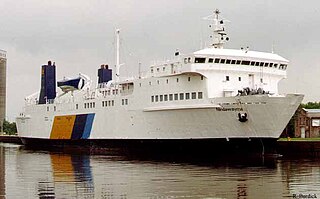
The MV Manx Viking / Nindawayma was a passenger, truck and car ferry, whose last active service was on Lake Huron, operated by the Owen Sound Transportation Company; under contract to the Ontario Ministry of Transportation. In Canadian service she served the Highway 6 route between Tobermory and South Baymouth, Manitoulin Island from 1989 to 1992 alongside the MS Chi-Cheemaun.
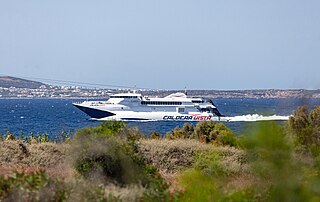
HSC Caldera Vista is an Incat-built high speed catamaran owned by Seajets. The vessel was the first fast craft to bear a Manx name. She was also the sixth Isle of Man Steam Packet Company vessel to bear the name Snaefell.

MV Ramsey was a coastal cargo vessel built for the Isle of Man Steam Packet Company in 1964. She was the last vessel specially built to serve the smaller ports of the Island.
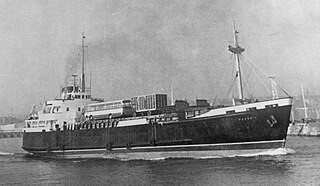
MV Peveril was a coastal cargo vessel operated by the Isle of Man Steam Packet Company. Peveril, the third ship in the company's history to bear the name, was built by Ailsa Shipbuilding Company at Troon, Scotland, in 1964.

SS (RMS) Tynwald (II), No. 45474, was an iron paddle-steamer which served with the Isle of Man Steam Packet Company, and was the second vessel in the Company to bear the name.
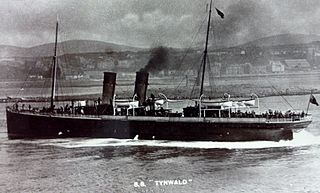
SS (RMS) Tynwald (III), No. 95755, was an iron passenger steamer which served with the Isle of Man Steam Packet Company, and was the third vessel in the Company to bear the name.

SS (RMS) Mona's Isle (I) was the first vessel ordered for service with the Isle of Man Steam Packet Company when it began its operation in 1830. No Official number is recorded for the vessel, as formal registration was not introduced until the Merchant Shipping Act 1854.

SS Cushag was a coastal cargo vessel owned and operated by the Isle of Man Steam Packet Company between 1920 and 1943.

SS (RMS) King Orry (II) No. 45479 – the second vessel in the company's history to bear the name – was an iron paddle-steamer operated by the Isle of Man Steam Packet Company.

SS (RMS) Douglas (III) – the third vessel in the line's history to bear the name – was a packet steamer which entered service with the London and South Western Railway in 1889 under the name Dora until she was purchased by the Isle of Man Steam Packet Company in 1901 for £13,500.

SS Empress Queen was a steel-hulled paddle steamer, the last of her type ordered by the Isle of Man Steam Packet Company. The Admiralty chartered her in 1915 as a troop ship a role in which she saw service until she ran aground off Bembridge, Isle of Wight, England in 1916 and was subsequently abandoned.

PS (RMS) Prince of Wales No. 93381 was a steel built paddle steamer which was purchased together with her sister PS Queen Victoria, by the Isle of Man Steam Packet Company from the Isle of Man, Liverpool and Manchester Steamship Company in 1888 - referred to as The Manx Line.

SS Conister (I) No. 145470 – the first vessel in the company's history to bear the name – was a coastal cargo vessel which was purchased by the Isle of Man Steam Packet Company from Cheviot Coasters Ltd, in 1932.
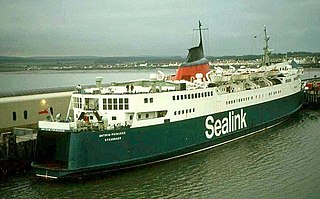
MV Tynwald was a roll-on-roll-off car and cargo vessel operated by the Isle of Man Steam Packet Company between 1986 and 1990, the sixth ship in the history of the line to bear the name. Built as Antrim Princess for service on the Stranraer–Larne route, she was chartered under her original name until 1986.

MV Conister (II) No. 187114 was a cargo vessel operated by the Isle of Man Steam Packet Company, the second vessel in the Company's history to bear the name.

SS (RMS) Mona (III), the third ship of the Company to bear the name, was a steel paddle-steamer which was originally owned and operated by the London, Chatham and Dover Railway Company, who then sold her to the Liverpool and Douglas Steamship Company, from whose liquidators she was acquired by the Isle of Man Steam Packet Company in 1903.

SS (RMS) Mona's Isle (III), No. 76304, the third ship in the company's history to be so named, was a paddle steamer which served with the Isle of Man Steam Packet Company until she was purchased by The Admiralty in 1915.

William Gill was a Manx merchant navy officer who served as commanding officer of numerous Isle of Man Steam Packet Company vessels. Gill was the first recognised captain of the line, retiring with the rank of Commodore.

SS (RMS) Ellan Vannin was an iron-built packet steamer which was operated out of Castletown, Isle of Man for the Castletown Steam Navigation Company to Liverpool and Whitehaven. Her name, Ellan Vannin, came from the Gaelic term by which the Isle of Man is known.
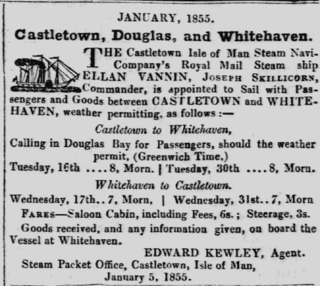
The Castletown Steam Navigation Company or Castletown Steam Navigation Company - also referred to as the Castletown Steam Packet Company - was a privately owned maritime transportation company incorporated in the Isle of Man. Its registered office was in Castletown, Isle of Man. By 1858 the company had run into significant financial difficulties which ultimately led to the sale of its vessel, the Ellan Vannin, and the winding up of the company.

























